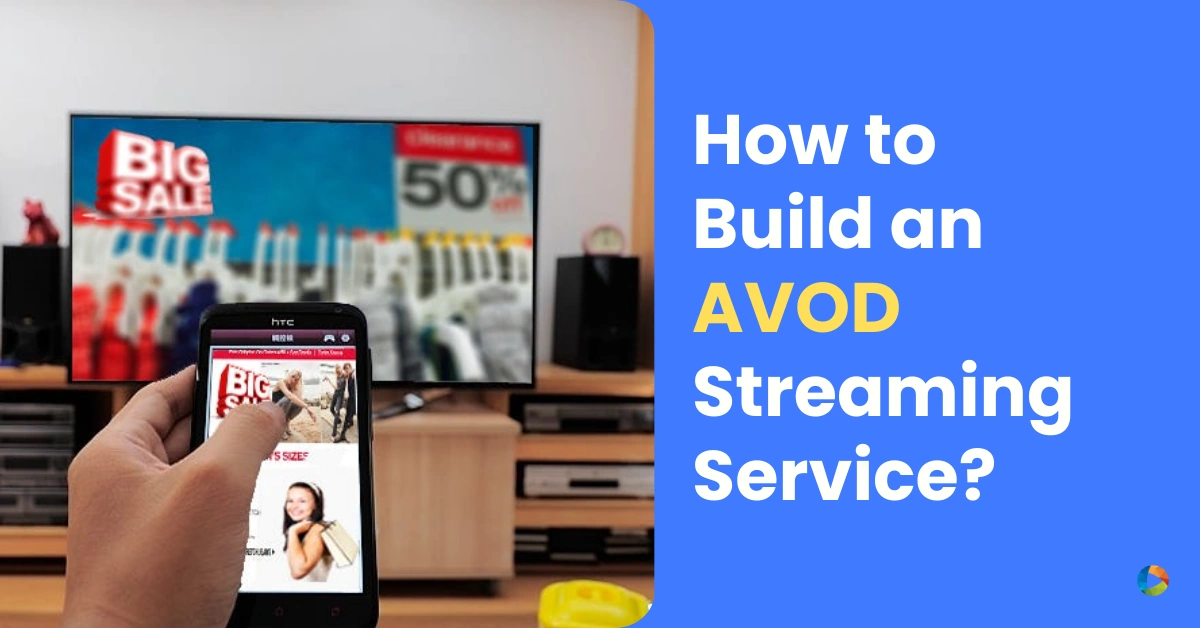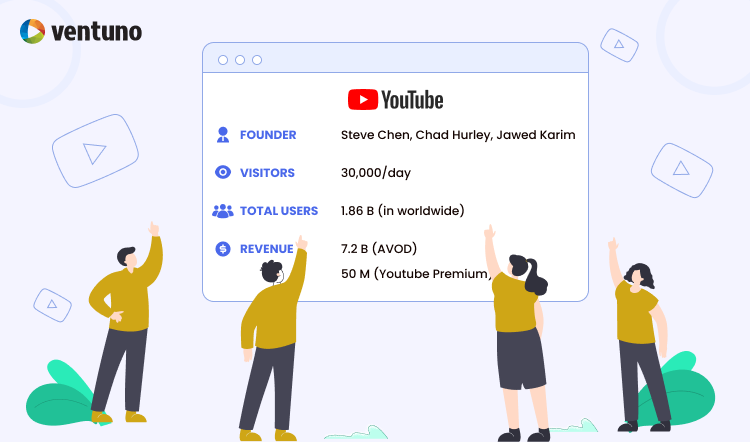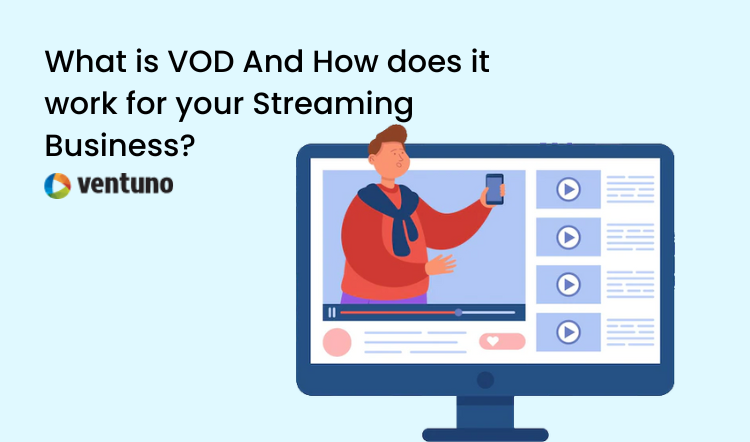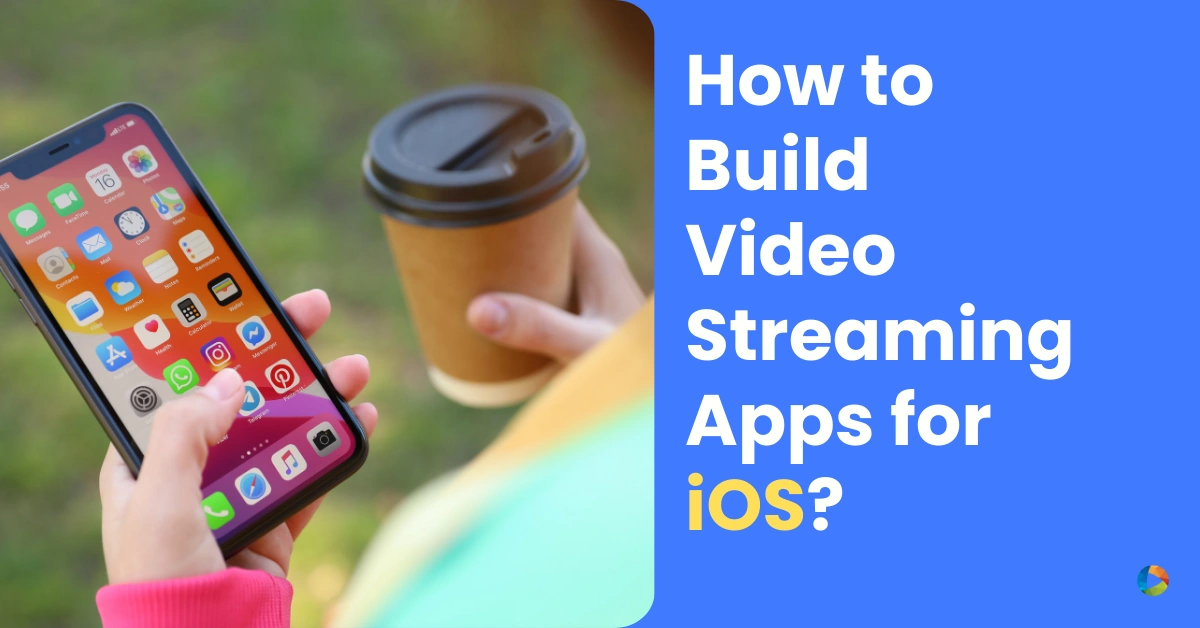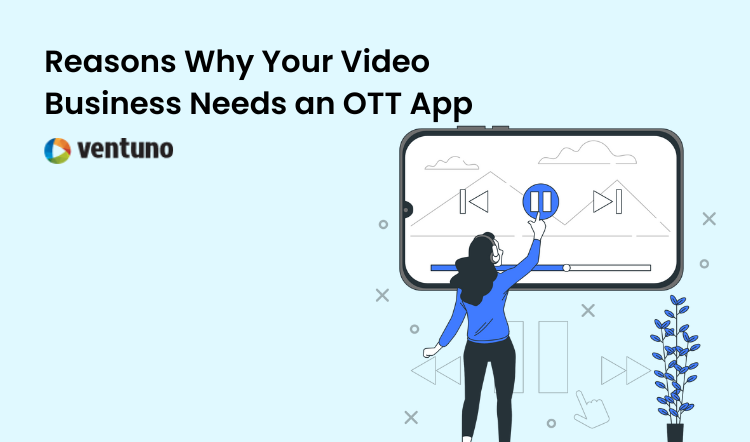How to Build a Successful AVOD Streaming Service?
Last Updated on May 20, 2025 by Anjana Devi
Until a few years back, content creators or broadcasters followed a distinct video monetization model. It used to be subscription versus advertising, where the market evolved from advertisements to subscription-based service.
But today, those lines are getting blurred and creators are experimenting with a hybrid model.
The global advertising-based video-on-demand market size was estimated at USD 49.04 billion in 2024 and is expected to grow at a CAGR of 29.2% from 2025 to 2030.
What we’re seeing is that content owners are enabling a free, ad-supported streaming model. At the same time, they also allow their viewers to upgrade or pay for an ad-free experience, converting them into paid subscribers.
In fact, well-established OTT players in the market like Hulu are leaning into the advertising model as it is making them more revenue than the actual subscription services.
Since AVOD is here to stay, streaming service providers have to understand this nuance to effectively run a successful AVOD streaming service.
In this article, we’re going to cover everything about how you can monetize your streaming business using the AVOD model, analyze your strengths and weaknesses, and understand the different costs involved.
Steps to Launch a Successful AVOD Service
Launching an AVOD streaming service requires the right mix of content, user experience, and monetization strategies. Here’s a step-by-step guide to getting it right.
Research Your Market
Start by understanding your audience and their content preferences. Analyze competitors to find gaps you can fill and learn from successful AVOD platforms. A well-researched approach will help you position your service effectively.
Define Your Niche
Rather than offering broad content, focus on a specific genre or interest, such as independent films, fitness, or niche sports. A clear niche helps attract a dedicated audience and makes it easier to secure relevant advertisers.
Secure High-Quality Content
Strong content is key to keeping viewers engaged. Partner with studios, indie filmmakers, or content creators through licensing deals or revenue-sharing models. A steady flow of fresh, high-quality content ensures long-term viewer retention.
Build a User-Friendly Platform
A smooth and intuitive platform is crucial for viewer retention. Ensure your website, mobile app, and TV app offer easy navigation, seamless playback, and a great viewing experience across all devices.
Develop Effective Ad Strategies
Ads drive revenue, but they need to be well-balanced. Offer targeted ad placements that enhance user engagement without overwhelming the experience. Advertisers value platforms that provide data-driven insights for better ROI.
Leverage Data and Analytics
Track viewer behavior, content performance, and ad effectiveness. Use analytics to improve recommendations, optimize ad placements, and boost retention. Data-driven decisions will help maximize revenue and engagement.
Plan a Strong Launch
A strategic launch builds momentum. Use social media, influencer partnerships, and industry events to generate buzz. Highlight what makes your platform unique and attract both viewers and advertisers.
By focusing on content quality, user experience, and smart monetization, you can build a successful AVOD streaming service that keeps viewers engaged and advertisers interested
Now that we’ve covered the basics, let’s dive into the costs involved in launching an AVOD streaming service.
Understanding Costs of Building an OTT Service
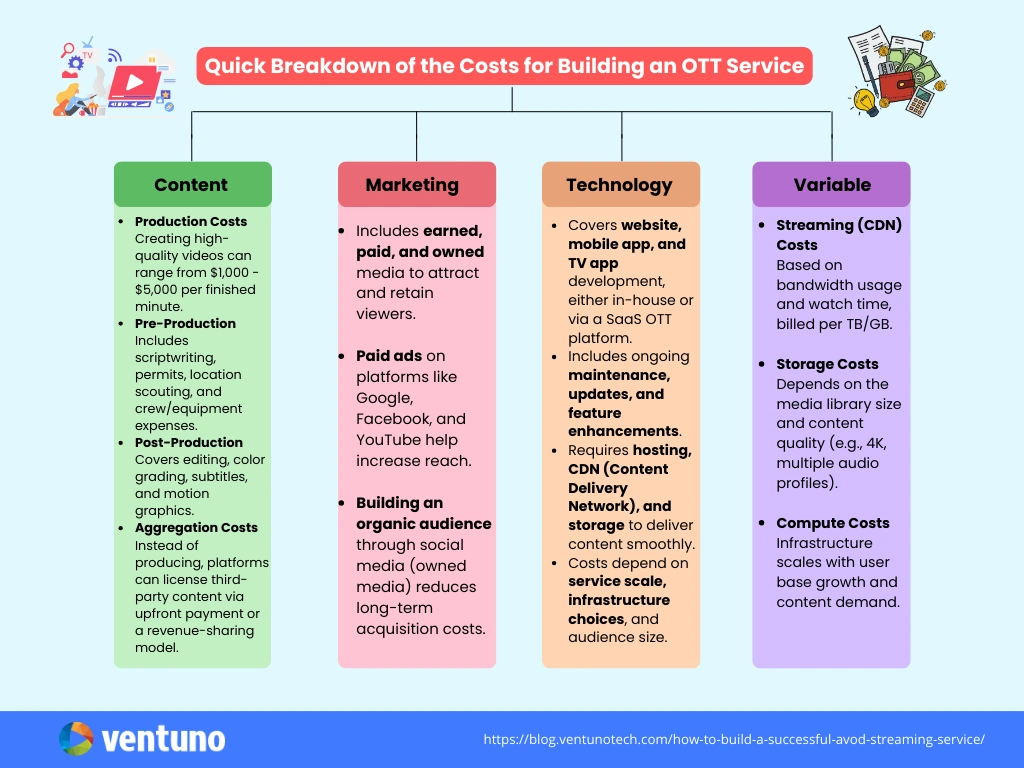
Streaming content has become one of the most common ways for people to entertain themselves. That’s why more and more video content creators are putting their focus on building their OTT app and putting their focus on monetizing using the AVOD model.
There’s no denying that the OTT industry will continuously evolve, but before jumping into it, it’s crucial to understand the various costs involved in building an OTT service for your audience.
Content Production Cost
Generally, video production costs more than any other content medium, but it’s also the most effective type.
If you want people to watch your video, you need to produce a video that’s worth watching. Say, for instance, you want to spend $1,000 for high-quality commercial production, it might not go well.
It is typically seen that a 2 to 3 minute professionally produced entertainment, or corporate video costs range from $2,000 to $7,000. Most production houses say that the average cost is usually around $1,000 to $5,000 per finished minute.
This number may vary vastly depending on the cost of different factors involved in the content-producing process. Yet again, if you want to retain your subscribers or viewers, you need to constantly upload new content. There are two ways of doing that – you can either create your own content or share your platform with other content creators (also known as aggregation).
Create Your Own Content
When you create your own content, you can break down your video production costs into two segments.
Pre-production Costs
Pre-production involves different activities, including writing a script, getting permits, location search, and scheduling shoots.
For location costs, it depends where you plan to shoot – indoor or outdoor – and if you need a stage or a studio. So, you need to budget in time and travel expenses.
There are also crew costs that depend on the complexity of your project. The length of your video, the number of people involved, and the budget. Besides, there are the equipment costs involved. All in all, the more intense your video is, the more it will cost.
Post-production Cost
This process includes editing videos with multiple rounds of feedback from your stakeholders, and then, there is coloring and grading. Generally, you need to find different people for different tasks. It can also include the cost of creating subtitles and motion graphics.
Aggregation Costs in OTT Space
Creating content is an expensive affair. While big players like Netflix can afford to create new content and upload them on a regular basis, it’s not feasible for small content creators.
Besides, consumers are frustrated with the number of platforms they need to subscribe to. Thus, OTT players are coming together to share a unified platform rather than using individual service apps or websites. So how does it work?
Either you pay a license fee upfront to other content creators, and you continue earning the revenue from their content. Or, you can enter into a revenue-sharing model whereby the platform tracks where the views are coming from, and accordingly, you both share the revenue.
This is a win-win situation as it saves you from incurring heavy production costs while also ensuring your viewers get a regular supply of new content in a single place.
Marketing Cost
When you think of starting your own OTT service, creators or producers need to be concerned about two things: getting new viewers and retaining the existing ones.
These two factors drive every single decision you make in growing your video streaming business. Even though there is no clear number on the average churn rate of the OTT industry, the churn rate is pretty high as it is easy to sign up and cancel subscription services.
But if your customer acquisition cost is not high, a high churn rate need not be a problem. In an AVOD service business, the main challenge is to get your video across more viewers.
In other words, effectively driving awareness is critical to your AVOD business. Many services struggle to find viewers simply because consumers do not know their platform exists. There are many cost-effective methods to promote your channel amongst your target audience.
Earned Media
Earned media is free publicity obtained through unpaid means that your company does not control, and it’s a tremendous marketing weapon. This could be from your viewers, the artists involved in your team, or an influencer in your domain.
Paid Media
If you want to bring traffic to your platform, it’s crucial to run ads on various platforms where your target audiences are hanging out. You can run ads on media channels like Google, Facebook, YouTube, or any other platform. Craft an appealing ad that increases the chance of your visitors converting into customers, making the most of your ad spend.
Owned Media
Owned media refers to having your own popular profile on various social media platforms where you can build your own community and engage with your followers. Here’s a good example of how Netflix does it – it has managed to build a community of 2.3 million followers over the years.
Make sure you measure all your marketing efforts so that you can easily tell which types of media are performing best for you and where there’s room for improvement.
Technology Costs
There are several technology-related costs associated with running a streaming platform.
You need to first invest in the development of a website, mobile app, and connected TV app. The cost will depend on whether you choose to develop in-house or choose a SaaS OTT platform provider. These technological assets also need to be maintained from time to time. You can even outsource it to a website/app development agency, but it can be on the expensive side.
Once your apps are developed, they need to be hosted and delivered to your end-users. Typically, you would need storage, streaming (CDN), and compute infrastructure that is world-class. AWS, Google, and Microsoft all provide these services. There are cheaper alternatives as well. Depending on the scale of your streaming service, these can range from a few hundred dollars a month to several thousand dollars a month.
With a SaaS platform like Ventuno, you dont have to worry about your compute, storage, or streaming needs. You can also easily integrate other CDN, and storage providers, but that means you will have to pay extra for those services.
Variable Costs
It doesn’t matter if you are building a solution in-house, outsourcing it, or using a Saas platform like Ventuno, you would have to deal with variable costs as your streaming service grows.
The three main things that you would need to look at are your streaming (CDN) costs, your storage costs, and your compute costs.
Variable Streaming (CDN) Costs
If you are an AVOD streaming service, then you need to keep a close eye on your streaming costs – also known as bandwidth costs or CDN costs.
Here, two variables are involved in determining bandwidth costs – the bit rate at which each user watches and time watched per subscriber and visitor (for ad-supported content) each month.
The cost to deliver a video is either billed per terabyte (TB) or per gigabyte (GB). Understanding CDN costs is the key to calculating the costs for building ad-supported content. You don’t want to choose an OTT platform provider that offers high CDN fees or the ability to integrate your preferred CDN. It will eat up all your profits once you start to scale.
It’s crucial to contract with a CDN provider that offers a committed rate card to minimize your costs. When you commit to a certain TB per month, the lower the cost per TB.
Ventuno offers a bandwidth calculator to help you get an idea of how much this costs for you.
Variable Storage Costs
Another cost you should be looking at but not really worried about is storage costs.
Depending on the size of your media library, how much this grows by month on month, and how many profiles of your content you create for each video asset for effective cross screen delivery, the costs could either sink you or not be an issue.
Are you going to provide a 4k video or make 5.1 audio available? Is your audience going to consume the content on mobile or CTV? Understanding not only your monetization model but also these data points will help you create the right profiles for your content to meet your audience’s viewing needs and save costs on your storage.
You should also ensure that your platform provider provides the necessary storage for your streaming needs and that the unit cost of your overages is in line with your economic model for your AVOD streaming service.
Variable Compute Costs
When you scale, you use more compute resources to serve your users with a flawless viewing experience.
As an AVOD streaming service, if your streaming service is reaching more audience month-on-month, your need for compute infrastructure would grow.
Also, imagine a new movie launch, a trendy new music video, a major new event, or a new episode of your popular show. All these could generate viewer interest at the same time. Even this would increase your compute infrastructure needs for that time.
Understanding the impact of your compute infrastructure, irrespective of if you are building this in-house or using a Saas platform like Ventuno, is crucial for the success of your streaming service.
What Drives in Revenue?
As a content creator, you can produce and publish videos and deliver them to audiences at a scale that you can sell to advertisers. This gives you a great opportunity to generate billions of dollars in revenue across the industry.
So, how do you make money through the AVOD platform? The core product is that you offer ad slots to these advertisers where they can display their products or services. It is generally divided into three spaces:
Pre-roll (before the content starts), Mid-roll (in the middle of the content), and Post-roll (after the video finishes).
To understand your revenue model through AVOD service, it’s crucial to understand how your slots are being sold and delivered. It is also known as Fill Rate.
Understanding Ad Fills
Fill rates refer to the percentage of how many times over a certain period are your ad slots getting filled. So if your fill rate is 20%, it would mean only 2 out of 10 slots have ads. Similarly, a 100% fill rate means you have ads in every slot all the time.
In simple words, ad fill rate is the ratio between the number of successfully delivered ads and the number of ad requests made by the ad server.
Fill Rate
Fill Rate = (ads served / total number of ads request ) x 100
These ad fill rates help you understand and decide how to further optimize your ad fills for the best outcomes.
Optimizing Ad Fills
When you run a fill rate analysis, you get to know where your ad slots are not filling and also the why part. This analysis leads to creating an action plan to fix these issues and start filling up your ad slots.
Developing a 100% fill rate benchmark might seem impossible, but you can always optimize them to achieve the best rate possible.
Here are the few things you can do –

Geo Targeting
Target by country, state, city.
Eg: Ads for local restaurants.
Content Targeting
Focus on genres.
Eg: Fitness brands on workout videos.
User Targeting
Show ads based on habits.
Eg: Tech ads for gadget enthusiasts.
Displaying relevant ads is crucial for boosting your site user’s experience. To do so, you need to leverage targeting options like location and behavioral targeting and serve high-quality ads.
Better targetted ads improve engagement, which drives more ad fills based on past history.
Improve Your Site’s and App’s Performance
Having a high performance website and apps adds to the ad experience and your overall performance. It’s crucial that not only your website and apps load faster, but also your ad loads fast and users don’t scroll down before viewing the ads.
Include Multiple Ad Formats
It’s important to optimize for multiple ad sizes to fit the broadest range of devices.
Get a Quality Ad Demand Partner
Getting your demand partners right is very important for your AVOD streaming service. Your ad inventory at scale will be global across devices and demography. Your demand partners should be able to fill the wide variety of ad inventory your AVOD streaming service creates.
Build a comprehensive strategy across demand partners to source the right mix for your needs. You can opt for three methods –
- Direct Sales: This is where you approach brands directly with the relevant target audience. For instance, if you create educational content for kids, you can target brands that sell baby products like Johnson & Johnson, FirstCry, etc.
That being said, large brands tie up with agencies that are responsible for displaying their ads on relevant platforms. In such cases, you can approach ad agencies. - Ad Agencies: Big brands like P&Gs, Coca-Cola, and others have contracts with ad agencies. As a content creator, you can tie-up with these ad agencies to display ads on your platforms or videos.
- Programmatic Advertising: Programmatic advertising refers to the use of automated technology for buying advertising space. For instance, you can partner up with Google AdX, OpenX, PubMatic, AppNexus for programmatic advertising, and they deliver ads that match your site’s and app’s look, feel, and function with customizable native ads. In short, they buy your advertising space and are responsible for displaying relevant ads based on various factors.
Various AVOD Payment Methods
There are various ways advertisers pay you for advertising in your videos. These media buying models include –
Cost Per Impression (CPI)
This model is about simply viewing your ads without taking any action. CPI is calculated based on the number of views on your ad display.
Cost Per Click (CPC)
Also known as PPC (pay per click), advertisers pay you for the number of clicks. These clicks can be for the touchscreen taps, remote button presses, keyboard or mouse button clicks.
Cost Per Mille (CPM)
CPM is the same as CPI except that M is the roman numeral for 1000. So, CPM means getting paid for every thousand impressions that you get.
Cost Per Action (CPA)
In CPA, advertisers only pay when users take a specific action like clicking on an ad, submitting a contact form, or making a reservation.
There are several other media buying models like CPL (Cost Per Lead), CPI (Cost Per Install), CPV (Cost Per View), CPCV (Cost Per Completed View).
What is right for you is the big question. The truth is that most media buyers reverse engineer a CPM rate for your inventory. So understanding what CPM you need to operate at for your streaming service helps you not only price your inventory but also help you understand your revenue potential.
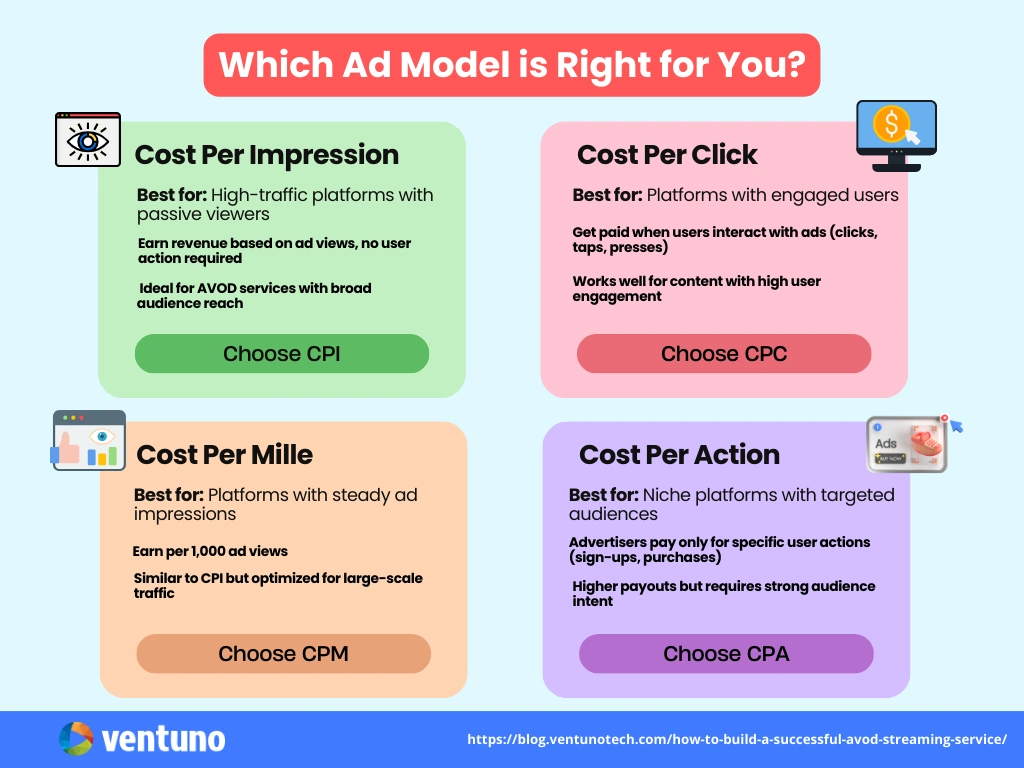
Analyze Your Strength and Weakness
There are three factors that decide the fate of your OTT service.
Content
The reason why OTT platforms are becoming so popular is because of the easy access to a vast set of content. However, an OTT business needs to ensure the quality of its original content for increasing audience engagement and sustaining its success.
There’s a need for unique and entertaining content for OTT monetization to increase user traction on your platform and thereby increase revenue. Yet again, many OTT content creators are facing the issue of content piracy.
If content piracy isn’t controlled, it can result in huge revenue losses.
Technology
Choosing the right technology for your OTT business is vital.
OTT platform technology is multidimensional, everything must work like a well-oiled machine, frictionless. The CMS, analytics, payment gateways, ad integrations, social syndication, and every other aspect to run your business must work synchronously.
Choosing a platform provider that will provide all this is crucial. Features to look in an OTT platform provider are here.
Users
Understanding your audience is, of course, crucial to developing a sustainable OTT platform. The type of audience you attract with your content decides your pricing model.
For instance, if your platform is a third choice for a user to watch a movie, they aren’t likely to give money to do so. In that case, the best option would be to opt for AVOD model. Simialrly, if you have premium content to offer, you can again go for AVOD streaming service to attract more users to your platform.
When you start knowing who your audiences are, you can run accurate ad targeting. Besides, you can recommend the right videos to your users and make them spend more time with your platform and make it their preferred streaming service.
Thus, it’s important to define your audience and keep track of who is viewing your content and what they prefer the most.
How Can Your Strengths Help You Earn Better Margins
The major advertising benefit of OTT platforms is how effectively you can engage with a young and larger media-consuming population. There has been a drop of 40% in cable TV consumption in the past five years by 18 to 24 years old.
Clearly, viewers are becoming more inclined towards OTT platforms. Besides, these viewers are highly receptive to OTT advertising. A survey revealed that 98% of the OTT device audience complete the ad.
That means if you’re able to draw the attention of your audience to your platform, you can earn better revenue.
A Look at YouTube
YouTube, which started out as a video-sharing platform for ordinary people to enjoy their “home videos,” is one of the top video streaming platforms today.
Founded in 2005 by American entrepreneurs named Steve Chen, Chad Hurley, and Jawed Karim, YouTube started attracting around 30,000 visitors per day. And by 2006, YouTube had more than 100 million videos per day.
At the time of this rapid growth, Google saw a great opportunity and acquired YouTube for $1.65 billion in stock in November 2006. Today, YouTube has approximately 1.86 billion YouTube users worldwide.
In 2015, YouTube launched its subscription service – YouTube Premium, to compete with Netflix. Even though YouTube Premium subscribers surpassed the 50 million mark in 2021, it still continues to earn huge revenue from its AVOD business. YouTube advertising revenue was $7.2 billion in 2021, up from $5 billion in 2020.
Its free, ad-supported content allows viewers to watch a wide variety of videos without paying anything, creating a huge impact.
Conclusion
With this guide, we aim to help video content creators understand and analyze different factors that help create a successful ad-based OTT service in this highly competitive marketplace.
Most importantly, you need to analyze your strengths and weaknesses based on your data. Granular insights into your data can help you optimize your OTT platform for greater user ad experience and create more efficiency across your network.
Investing in a platform that will help you properly capture data and deliver a superior experience to your audience will lead to your most profitable advertising video business.
Looking to launch your AVOD streaming service?

